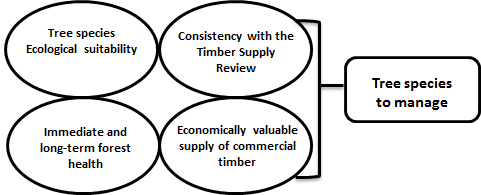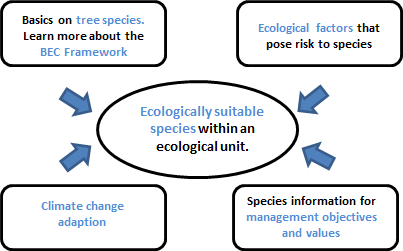Tree Species Selection Tool
The Tree Species Selection Tool (TSST) provides forest practitioners with the best available science-based information about tree species selection for a given geographical location. It informs tree species selection decision-making at the stand- and landscape-level, in the context of a changing climate.
TSST helps to:
- Search for and identify tree species that are ecologically suitable within a specified biogeoclimatic (BEC) subzone variant to the site series level
- Understand the historical species composition of the ecological unit, species deployment trends, and climate adaptation strategies (principles or strategies for managing for resilient ecosystems in the context of climate change)
- Access information about ecological risk factors (forest health, environmental) associated with a list of ecologically suitable species
A core element of the TSST is ecologically suitable species and landscape-level species descriptions by BEC subzone/variant.
Tool background
Tree species selection is a key factor in preparing forest stewardship plans and site-level tree species selection and sowing requests.
The TSST includes:
- Information on ecologically suitable tree species (climatically suitable species and populations)
- Landscape-level descriptions of the tree species for a given biogeoclimatic ecosystem classification (BEC) subzone/variant

It presents species that naturally occur regardless of management objective, providing biologically based options to practitioners managing for uncertainty within a BEC framework.
TSST ecologically suitable species are different from the tables in the Establishment to Free Growing Guidebook (EFG) and Reference Guide for Forest Development Plan (FPD) stocking standards (XLSX, 506KB) because species management decisions are guided by management objectives. The species selected will differ depending on the resource manager’s management objectives and values.
A listing of ecologically suitable species has been reviewed and drafted for each BEC subzone/variant’s site series, without being filtered for a management objective so the TSST has flexibility to serve the broad range of management objectives and values. The tree species and stocking standards initially provided in the EFG guidebooks and the reference guide were reviewed in the context of a sawlog timber management objective, and may be still appropriate for that purpose where applicable. The TSST is a source of best available scientific information, especially as it relates to tree species and climate change. The end result of the non-filtered review is that there are some differences, minor in most cases, for certain BEC subzone/variants.
Ecologically suitable tree list development
The lists were developed with input from regional ecologists, silviculturists and forest health specialists, and government staff and the following information sources:
Source information
Source information for the preliminary review included:
- Provincial BEC master plot data
- The reference guide for developing FDP stocking standards (November 2010) primary, secondary, tertiary and broadleaf species lists
Preliminary review principles
Preliminary review principles for including species on the list were that they must:
- Meet the TSS working group’s definition of an ecologically suitable species
- Not meet any of the exclusion criteria, mainly that
- the species' occurrence is due to a transitional area
- the species is uncommon to a BEC site series
- the species is at the extent of its range
Ecologically suitable tree species
Draft list of ecologically suitable tree species for a BEC subzone/variant by site series
Follow-up
Follow-up review with other specialists and staff with local expertise
Final draft
Final draft ecologically suitable tree species table was created for each BEC subzone/variant – then it was added to the appropriate zone workbook
Four supporting elements:
BEC framework
Biogeoclimatic ecosystem classification resource materials (for example, maps, field guides)
Tree species silvics and ecology - tree species compendium
Ecological factors
Ecological factors determine risks to tree species' ecological suitability.
Species information
Information to assist in evaluating tree species in the context of management objectives/values, such as:
- Timber
- Wildlife habitat
- Fuel and fire management
- Carbon
- Visual quality
Climate change adaptation
Climate science and tree species information to consider in developing adaptation strategies. Read more background and detailed information on climate change adaptation.

